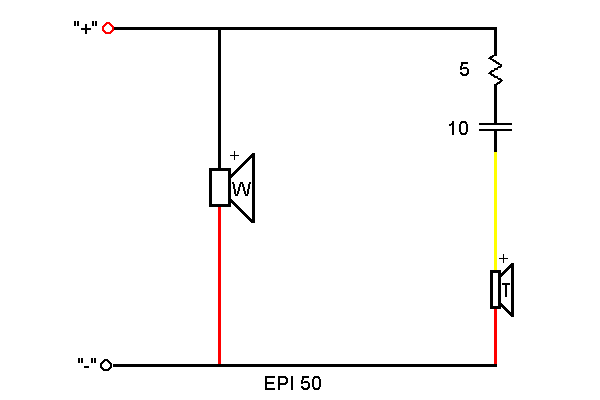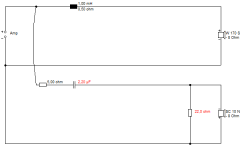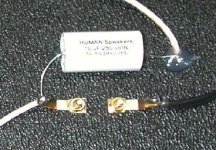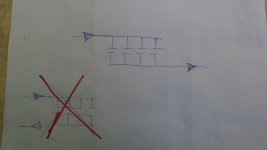I am recapping a very simple crossover with an electrolytic shunted with a .01uf bypass film cap. I think I hear a slight improvement the upper end, but I feel I could still use some brightening. Would it be possible to increase the bypass cap value to .22uf or .33uf without incident. What frequencies to these affect. I mean, does a .22uf cap affect frequencies in the 2,200khz range? Is that how this all works?
Increasing the value of capacitance in series with a tweeter would normally increase its output at the lower end of its passband. Bypassing a capacitor is intended to mitigate the effect of physical limitations of a capacitor at higher frequencies.
If you intend to change the value, might I suggest trying a single capacitor that is less in need of bypassing? For the time being however, just add capacitance until you find what you're looking for.
If you intend to change the value, might I suggest trying a single capacitor that is less in need of bypassing? For the time being however, just add capacitance until you find what you're looking for.
Increasing the value of capacitance in series with a tweeter would normally increase its output at the lower end of its passband. Bypassing a capacitor is intended to mitigate the effect of physical limitations of a capacitor at higher frequencies.
If you intend to change the value, might I suggest trying a single capacitor that is less in need of bypassing? For the time being however, just add capacitance until you find what you're looking for.
Thank you. I bypassed the capacitor with a Vitamin Q sprague, but then I realized they are know for a soft high end. So that was a bit silly. I happen to have another bipolar Vitamin Q with a value of .33uf which is the extreme end jump, but at least might make such a dramatic diffrence I can definitively say that I'm not completely deaf over 5k.
Z of 0.33 uF @ 2200 Hz = 219 ohms. Heck, at 10 kHz it's just under 50 ohms. Any electrolytic that's still got a pulse will be an order of magnitude (or several) lower than that even at the higher frequencies. IMO, it takes a surprisingly large bypass to accomplish much, unless there's something else going on that's yet to be described.
Bypassing seems a bit of a waste of time. Replace the tweeter capacitor with a 250V polypropylene and it'll sound brighter anyway, because they have about 0.5R less resistance (ESR is the word, I think). Often a good idea to shunt a 22R 7W resistor across the tweeter too. Sounds smoother with a lot of amps.
Hard to be more precise without seeing the crossover.
Hard to be more precise without seeing the crossover.
Bypassing seems a bit of a waste of time. Replace the tweeter capacitor with a 250V polypropylene and it'll sound brighter anyway, because they have about 0.5R less resistance (ESR is the word, I think). Often a good idea to shunt a 22R 7W resistor across the tweeter too. Sounds smoother with a lot of amps.
Hard to be more precise without seeing the crossover.
I first replaced the electrolytic with a decent film cap but it changed the sound signature too much for my liking .. it became too bright. I might have been hearing the restored highs that were lost with an aging cap, but now the speakers were just too bright for me. So I put in a new electrolytic cap and liked the balance better, but missed just a bit of top end energy of the film cap. That's why I put the bypass in, hoping it might brighten the top end a little more. Whether or not it did is a toss up to my ears at this point. I think I hear a bit more reverb than I originally did, but there's still not a lot of air. Either I want to increase the "contribution" of another Vitamin Q bypass or try another kind of film cap known for more high frequency energy like a Vishay. But maybe you're right and it's a waste of time. The jury is out on it, it seems.
Here's the crossover. Not much to see, really.

Last edited:
I am recapping a very simple crossover with an electrolytic shunted with a .01uf bypass film cap. I think I hear a slight improvement the upper end, but I feel I could still use some brightening. Would it be possible to increase the bypass cap value to .22uf or .33uf without incident. What frequencies to these affect. I mean, does a .22uf cap affect frequencies in the 2,200khz range? Is that how this all works?
Hi Solder,
I think you should try a good film cap to replace the electrolytic. Try a Mundorf MKP or Bennic.
If you'd like to experiment with crossover values, I suggest you download XSim to get an intuitive feel for how changing the crossover values may affect the speaker output. You can grab driver FRD/ZMA files from Parts Express for any Dayton Audio drivers. Probably not what you are using, but this combination makes for a free learning laboratory.
My one tip is to get used to using the ground symbol instead of drawing wires to the (-) amplifier terminal.
Best,
Erik
....................
My one tip is to get used to using the ground symbol instead of drawing wires to the (-) amplifier terminal..............
And I recommend the opposite.
Show the real Flow and Return wires and forget about "grounds"
I'll never understand why anybody invented that horrible word "ground".
I confuses almost everyone, especially in the USA where they even refer to the Protective Earth as "ground".
And I recommend the opposite.
Show the real Flow and Return wires and forget about "grounds"
I'll never understand why anybody invented that horrible word "ground".
I confuses almost everyone, especially in the USA where they even refer to the Protective Earth as "ground".
Yeah, especially those who don't understand the difference between a schematic and a circuit board.
The ground symbol is just short hand saying "this goes to the same net." If you can accomplish that bit of mental gymnastics you cut your wires in half and make the schematic easier to understand, when appropriate. Since XSim is a crossover simulator, there is no reason to have multiple ground types.
Erik
Place the small bypass capacitor across the 5 ohm resistor. This will increase the output by bypassing the resistor at higher frequencies
Interesting! Thank you!
That is the mistake. All the "grounds" are actually returns and they are NOT on the same "net"............The ground symbol is just short hand saying "this goes to the same net." .............
Each circuit has it's own Flow and Return. The Return must not be separated from the flow, otherwise you introduce avoidable interference.
Draw every circuit with a Flow and Return and forgat about "shorthand" tricks that confuse.
These speakers are nearly 50 years old! 
HUMAN Speakers: EPI 50 information
Curiously you can buy an updated crossover for them, it consists essentially of a film 10uF capacitor. I wouldn't consider a little tweeter attenuation to be rocket science. A 22R ought to do it.
What they DO have is an amazingly flat impedance and power response and good transient response. The frequency response and quality and distortion aspects are more difficult, and phase is all over the place. Requires a very good bass with a smooth natural rolloff and a tough tweeter.
Having seen this sort of thing before, the design evolved into something like the below in the Epos M12 and MS 10i designed by Robin Marshall. A series crossover might work well too IMO.
HUMAN Speakers: EPI 50 information
Curiously you can buy an updated crossover for them, it consists essentially of a film 10uF capacitor. I wouldn't consider a little tweeter attenuation to be rocket science. A 22R ought to do it.
What they DO have is an amazingly flat impedance and power response and good transient response. The frequency response and quality and distortion aspects are more difficult, and phase is all over the place. Requires a very good bass with a smooth natural rolloff and a tough tweeter.
Having seen this sort of thing before, the design evolved into something like the below in the Epos M12 and MS 10i designed by Robin Marshall. A series crossover might work well too IMO.
Attachments
Last edited:
These speakers are nearly 50 years old!
HUMAN Speakers: EPI 50 information
Curiously you can buy an updated crossover for them, it consists essentially of a film 10uF capacitor. I wouldn't consider a little tweeter attenuation to be rocket science. A 22R ought to do it.
What they DO have is an amazingly flat impedance and power response and good transient response. The frequency response and quality and distortion aspects are more difficult, and phase is all over the place. Requires a very good bass with a smooth natural rolloff and a tough tweeter.
Having seen this sort of thing before, the design evolved into something like the below in the Epos M12 and MS 10i designed by Robin Marshall. A series crossover might work well too IMO.
System 7, I have really to ask you to improve my main Lynnfield speaker
 unluckilly !
unluckilly !- Status
- This old topic is closed. If you want to reopen this topic, contact a moderator using the "Report Post" button.
- Home
- Loudspeakers
- Multi-Way
- Raising values in crossover bypass caps


